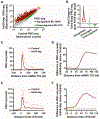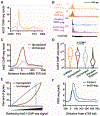The Integrator Complex Attenuates Promoter-Proximal Transcription at Protein-Coding Genes
- PMID: 31809743
- PMCID: PMC6952639
- DOI: 10.1016/j.molcel.2019.10.034
The Integrator Complex Attenuates Promoter-Proximal Transcription at Protein-Coding Genes
Abstract
The transition of RNA polymerase II (Pol II) from initiation to productive elongation is a central, regulated step in metazoan gene expression. At many genes, Pol II pauses stably in early elongation, remaining engaged with the 25- to 60-nt-long nascent RNA for many minutes while awaiting signals for release into the gene body. However, 15%-20% of genes display highly unstable promoter Pol II, suggesting that paused polymerase might dissociate from template DNA at these promoters and release a short, non-productive mRNA. Here, we report that paused Pol II can be actively destabilized by the Integrator complex. Specifically, we present evidence that Integrator utilizes its RNA endonuclease activity to cleave nascent RNA and drive termination of paused Pol II. These findings uncover a previously unappreciated mechanism of metazoan gene repression, akin to bacterial transcription attenuation, wherein promoter-proximal Pol II is prevented from entering productive elongation through factor-regulated termination.
Keywords: Integrator complex; enhancer RNA; histone methylation; polymerase pausing; transcription regulation; transcription termination.
Copyright © 2019 Elsevier Inc. All rights reserved.
Conflict of interest statement
DECLARATION OF INTERESTS
The authors declare no competing interests.
Figures







Similar articles
-
Kinetics of promoter Pol II on Hsp70 reveal stable pausing and key insights into its regulation.Genes Dev. 2014 Jan 1;28(1):14-9. doi: 10.1101/gad.231886.113. Genes Dev. 2014. PMID: 24395245 Free PMC article.
-
Stable pausing by RNA polymerase II provides an opportunity to target and integrate regulatory signals.Mol Cell. 2013 Nov 21;52(4):517-28. doi: 10.1016/j.molcel.2013.10.001. Epub 2013 Oct 31. Mol Cell. 2013. PMID: 24184211 Free PMC article.
-
Integrator Recruits Protein Phosphatase 2A to Prevent Pause Release and Facilitate Transcription Termination.Mol Cell. 2020 Oct 15;80(2):345-358.e9. doi: 10.1016/j.molcel.2020.08.016. Epub 2020 Sep 22. Mol Cell. 2020. PMID: 32966759 Free PMC article.
-
Getting up to speed with transcription elongation by RNA polymerase II.Nat Rev Mol Cell Biol. 2015 Mar;16(3):167-77. doi: 10.1038/nrm3953. Epub 2015 Feb 18. Nat Rev Mol Cell Biol. 2015. PMID: 25693130 Free PMC article. Review.
-
Regulation of snRNA gene expression by the Drosophila melanogaster small nuclear RNA activating protein complex (DmSNAPc).Crit Rev Biochem Mol Biol. 2011 Feb;46(1):11-26. doi: 10.3109/10409238.2010.518136. Epub 2010 Oct 6. Crit Rev Biochem Mol Biol. 2011. PMID: 20925482 Review.
Cited by
-
SUMO conjugation regulates the activity of the Integrator complex.Nucleic Acids Res. 2022 Nov 28;50(21):12444-12461. doi: 10.1093/nar/gkac1055. Nucleic Acids Res. 2022. PMID: 36454007 Free PMC article.
-
INTS11-related neurodevelopmental disorder: a case report and literature review.J Hum Genet. 2024 Dec;69(12):669-673. doi: 10.1038/s10038-024-01276-z. Epub 2024 Jul 19. J Hum Genet. 2024. PMID: 39030370 Review.
-
Enhancers regulate 3' end processing activity to control expression of alternative 3'UTR isoforms.Nat Commun. 2022 May 17;13(1):2709. doi: 10.1038/s41467-022-30525-y. Nat Commun. 2022. PMID: 35581194 Free PMC article.
-
ATAC-seq Optimization for Cancer Epigenetics Research.J Vis Exp. 2022 Jun 30;(184):10.3791/64242. doi: 10.3791/64242. J Vis Exp. 2022. PMID: 35848835 Free PMC article.
-
CRISPR-ChIP reveals selective regulation of H3K79me2 by Menin in MLL leukemia.Nat Struct Mol Biol. 2023 Oct;30(10):1592-1606. doi: 10.1038/s41594-023-01087-4. Epub 2023 Sep 7. Nat Struct Mol Biol. 2023. PMID: 37679565
References
-
- Andersson R, Sandelin A, and Danko CG (2015). A unified architecture of transcriptional regulatory elements. Trends in Genetics 31, 426–433. - PubMed
-
- Arnold CD, Gerlach D, Stelzer C, Boryń ŁM, Rath M, and Stark A (2013). Genome-wide quantitative enhancer activity maps identified by STARR-seq. Science 339, 1074–1077. - PubMed
-
- Austenaa LMI, Barozzi I, Simonatto M, Masella S, Chiara, Della G, Ghisletti S, Curina A, de Wit E, Bouwman BAM, de Pretis S, et al. (2015). Transcription of Mammalian cis-Regulatory Elements Is Restrained by Actively Enforced Early Termination. Molecular Cell 60, 460–474. - PubMed
Publication types
MeSH terms
Substances
Grants and funding
LinkOut - more resources
Full Text Sources
Molecular Biology Databases
Research Materials

